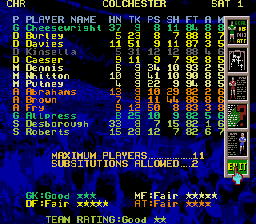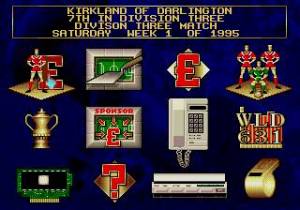
On Her Majesty’s Sega Mega Drive
Premier Manager Review
The beautiful game is ubiquitous in the UK, and even more so when it comes to video games. The last instalment of Fifa sold 800,000 copies for PS4 in the UK alone – compare that to 551k in the USA; the gap only get bigger across all consoles, because frankly, at this stage, Fifa‘s been on more platforms than Mario, Crash and Spyro combined. However, it’s not just the aspect of playing football that interests people – football management has captured gamers’ imagination for well over twenty years. To go back to the stats again, Football Manager 2015 has done 180k units in the UK, while the numbers are so low in the US that they’ve failed to even appear on the radar. The popularity of these games resounds in the UK like fans cheering at Wembley Stadium, which brings us onto today’s game: Premier Manager, which was only ever released in Europe, specifically aiming at a British audience. The question today: is this managerial sim like a shot in the back of the net, or is it offside?
For those out of the loop: a managerial football sim is exactly as it sounds. You’re put into the shoes of a club manager, and from there you make decisions about who’s on the team, training regimes, bringing in new players, how the team will play during matches, and a host of other options. As such, these games tend to be quite deep in terms of options available to the player. This begs the question: how could the developers get a game like this, which you would assume would have a massive scope, on such a small cartridge?
When I started the game, I was expecting a shallow but playable little sim that would let you play a season, buy some players, put some basic tactics into action and not much else. However, the true depth of this game hit me like an overhead kick to the chest. You can play through the four top leagues of the English football system, sign sponsors, expand your stadium, even look at the statistics for the last match played in painstaking detail. This would be par for the course (bugger, wrong sport!) for a football management game these days, but for a mid-90s game on a home console, the depth of the game is staggering.

Build your team into a powerhouse by putting players in the right place, and transferring in new ones to give your squad the edge.
However, perhaps the best part of the whole game is the ability to save. Of course, saving in a game with a massive campaign is essential – passwords would be less than useless for a game like this. This allows you to make your way through a multi-year campaign, where you build up your non-league team into a Premier League powerhouse to be reckoned with. While, again, this is commonplace today, it ends up feeling like a real accomplishment for a Mega Drive game – I can’t think of any other games on the system that had the ability to do that.
Yet, while they’ve packed a lot into a tiny cartridge, I can’t help wondering if it’s all a bit pointless. Let’s not get this wrong: the content of the game is impressive. However, I’m doubtful if this would be a comfortable game to play full-time: there’s a reason that Football Manager and Championship Manager found a home on PC. While the micro-management aspect of this game is very well implemented, it starts to get a bit tiresome controlling it all with a Mega Drive pad, staring at a television screen at a distance. Of course, this is very subjective, but personally, I feel like this isn’t the optimum way to play this game.
As it stands, though, the visual presentation is surprisingly fantastic. Until quite recently, these managerial games weren’t exactly a treat to look at – mostly, they were all wall-to-wall facts, figures, and information pasted in front of a picture of a non-league game being played to about 12 people. However, the 16-bit aesthetic of the Mega Drive lends the game some charm: particularly in the match screens themselves, which turn out to be the best part of the game. As you’re the manager, you won’t be seeing any part of the field – your view is instead a dashboard showing the score, game stats, and an old-style screen that flashes up with slightly-rubbish but endearing animations of the players at work, punctuated with big words appearing like “MISS”, “SAVE” and “GOAL”. Visuals are never important in this genre, but Premier Manager‘s are certainly good enough to make the game more roundly appealing.
The sound design is limited here, but this is a rare case in that no music or real sound for the most part does the game favours. Aside from a few pings to alert you when you’re changing to another screen or generic crowd noises during matches, Premier Manager keeps the bulk of the game in silence. However, I quite liked this – it cleared my head and allowed me to plan out my strategies for the next game ahead, further immersing me in the game. The game does feature a title track, and for having virtually no music, they really scored a massive goal here on this one track. A jazzy little number, it’s a good song that has no reason to be there and doesn’t make the game any better, but it’s still a nice little tune.
For being so feature-rich at the time of its release, Premier Manager still feels like it would make a decent release if it came out now. Of course, it feels outdated now – the game covers the 1995/96 season, and top-flight players cost about £2.3 million adjusted for inflation; current players wouldn’t even get out of bed for that. Still, for all that it was and is, PremierManager is still an incredibly robust sim, and is probably best recommended to those who fondly remember football from that era.
